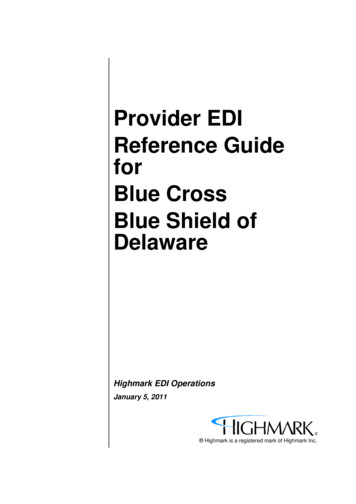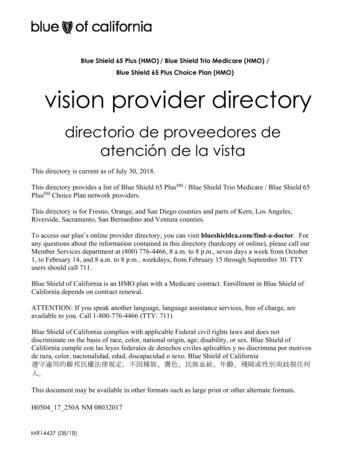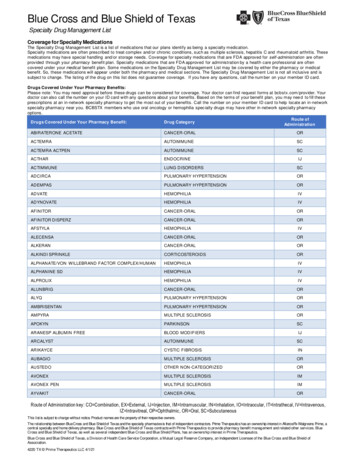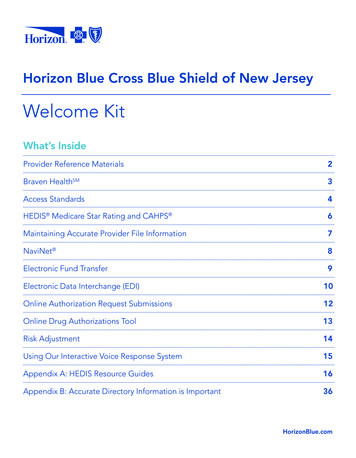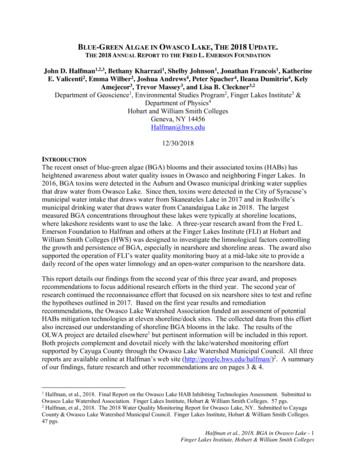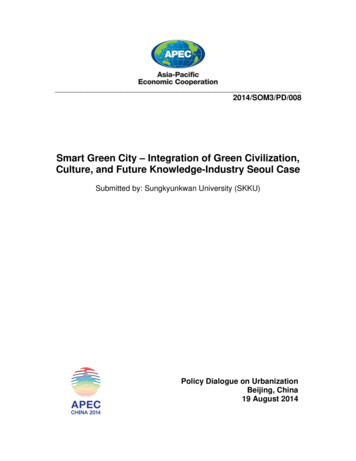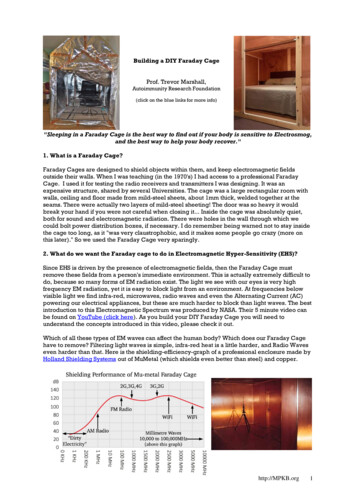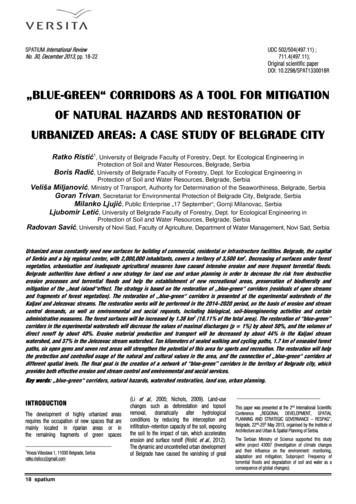
Transcription
SPATIUM International ReviewNo. 30, December 2013, pp. 18-22UDC 502/504(497.11) ;711.4(497.11);Original scientific paperDOI: 10.2298/SPAT1330018R„BLUE-GREEN“ CORRIDORS AS A TOOL FOR MITIGATIONOF NATURAL HAZARDS AND RESTORATION OFURBANIZED AREAS: A CASE STUDY OF BELGRADE CITYRatko Ristić1, University of Belgrade Faculty of Forestry, Dept. for Ecological Engineering inProtection of Soil and Water Resources, Belgrade, SerbiaBoris Radić, University of Belgrade Faculty of Forestry, Dept. for Ecological Engineering inProtection of Soil and Water Resources, Belgrade, SerbiaVeliša Miljanović, Ministry of Transport, Authority for Determination of the Seaworthiness, Belgrade, SerbiaGoran Trivan, Secretariat for Environmental Protection of Belgrade City, Belgrade, SerbiaMilanko Ljujić, Public Enterprise „17 September“, Gornji Milanovac, SerbiaLjubomir Letić, University of Belgrade Faculty of Forestry, Dept. for Ecological Engineering inProtection of Soil and Water Resources, Belgrade, SerbiaRadovan Savić, University of Novi Sad, Faculty of Agriculture, Department of Water Management, Novi Sad, SerbiaUrbanized areas constantly need new surfaces for building of commercial, residental or infrastructure facilities. Belgrade, the capitalof Serbia and a big regional center, with 2,000,000 inhabitants, covers a teritorry of 3,500 km2. Decreasing of surfaces under forestvegetation, urbanisation and inadequate agricultural measures have caused intensive erosion and more frequent torrential floods.Belgrade authorities have defined a new strategy for land use and urban planning in order to decrease the risk from destructiveerosion processes and torrential floods and help the establishment of new recreational areas, preservation of biodiversity andmitigation of the „heat island“effect. The strategy is based on the restoration of „blue-green“ corridors (residuals of open streamsand fragments of forest vegetation). The restoration of „blue-green“ corridors is presented at the experimental watersheds of theKaljavi and Jelezovac streams. The restoration works will be performed in the 2014–2020 period, on the basis of erosion and streamcontrol demands, as well as environmental and social requests, including biological, soil-bioengineering activities and certainadministrative measures. The forest surfaces will be increased by 1.38 km2 (18.11% of the total area). The restoration of “blue-green”corridors in the experimental watersheds will decrease the values of maximal discharges (p 1%) by about 50%, and the volumes ofdirect runoff by about 40%. Erosive material production and transport will be decreased by about 44% in the Kaljavi streamwatershed, and 37% in the Jelezovac stream watershed. Ten kilometers of sealed walking and cycling paths, 1.7 km of unsealed forestpaths, six open gyms and seven rest areas will strengthen the potential of this area for sports and recreation. The restoration will helpthe protection and controlled usage of the natural and cultural values in the area, and the connection of „blue-green“ corridors atdifferent spatial levels. The final goal is the creation of a network of “blue-green” corridors in the territory of Belgrade city, whichprovides both effective erosion and stream control and environmental and social services.Key words: „blue-green“ corridors, natural hazards, watershed restoration, land use, urban planning.INTRODUCTION 1The development of highly urbanized areasrequires the occupation of new spaces that aremainly located in riparian areas or inthe remaining fragments of green spaces1Kneza Višeslava 1, 11030 Belgrade, Serbiaratko.risticc@gmail.com18 spatium(Li et al., 2005; Nichols, 2009). Land-usechanges such as deforestation and topsoilremoval, dramatically alter hydrologicalconditions by reducing the interception andinfiltration–retention capacity of the soil, exposingthe soil to the impact of rain, which accelerateserosion and surface runoff (Ristić et al., 2012).The dynamic and uncontrelled urban developmentof Belgrade have caused the vanishing of greatThis paper was presented at the 2nd International ScientificConference „REGIONAL DEVELOPMENT, SPATIALPLANNING AND STRATEGIC GOVERNANCE – RESPAG”,Belgrade, 22nd-25th May 2013, organised by the Institute ofArchitecture and Urban & Spatial Planning of Serbia.The Serbian Ministry of Science supported this studywithin project 43007 (Investigation of climate changesand their influence on the environment: monitoring,adaptation and mitigation; Subproject: Frequency oftorrential floods and degradation of soil and water as aconsequence of global changes).
Ristić R. et al.: „Blue-green“ corridors as a tool for mitigation of natural hazards and restoration of urbanized areas: A case study of Belgrade citygreen complexes and the occupation of spaces inriparian areas, and this is still an ongoing process:construction of the apartment and office block onthe edge of the Terazije plateau; a large number ofapartment blocks on the left bank of the SavaRiver, in the area intended for flood protection andrecreation; illegal construction on the edge of thepark forest Zvezdani Gaj; the disappearance offorest areas near the Lisičji stream. The core of thecity area involves a few dozens of watercourses,with fully or partly urnbanized watersheds, whichhave been introduced into the sewerage system(the Čuburski, Kumodraški, Mokroluški, andŽarkovački streams, etc.). Numerous importantcity streats were built just above former streambeds (South boulevard, and Nemanjina streat,etc). At the same time, some big cities in theworld can show different examples that are in linewith the modern urban sensibility and ecologism.These examples are the restoration of theCheonggyecheon stream in Seoul (SeoulDevelopment Institute, 2003), or the locality DonValley Brick Works in Toronto (Foster, 2005).functions: mitigation of the „heat island“ effect,terrain drainage, sports and recreation,restoration of autochtonous flora and fauna,aesthetic and visual effects.MATERIAL AND METHODSThe concept of restoration of the “blue-green”corridors is presented at two experimentalwatersheds of the Kaljavi and Jelezovac streams,just a few kilometres from the centre of Belgrade(Figure 2). The main hydrographic characteristicsof the experimental watersheds are presented inTable 1. The experimental watershedsexperienced torrential floods (in 1965, 1994,2002), which endangered buildings, land androads, when the water levels increased from0.10–0.15 m to 1.6 m (the Kaljavi stream) andBelgrade, the capital of Serbia and a big regionalcentre with a population of 2,000,000, covers aterritory of 3,500 km2. The territory of Belgradehas 187 streams with watersheds that are mostlyrural in the higher parts and urbanized or highlyurbanized in the lower parts (Faculty of Forestry &Institute for Water Resources Management“Jaroslav Černi”, 2005). A high concentration ofhousing, office and infrastructural facilities madeBelgrade poor in green areas compared to othercities in Europe. Green areas occupy 14 m2 percapita at the city level, whereas in some parts ofthe city, such as Vračar, they cover only 2 m2 percapita (Urbanistic Institute of Belgrade, 2001).The authorities of Belgrade defined a strategy forerosion and torrent control based on therestoration of “blue-green” corridors. Therestoration of “blue-green” corridors helps theestablishment of new recreational areas,preservation of biodiversity (Saumel and Kowarik,2010; Ramirez and Zuria, 2011) and urbanadaptation to climate change (Kazmierczak andCarter, 2010). The restoration of „blue-green“corridors is presented at the experimentalwatersheds of the streams Kaljavi and Jelezovac.The „blue-green“ corridors conceptEach watershed contains certain elements thatcan be unconnected (isolated), which gives thema static character, or functionally connected,which gives them a dynamic character (Figure 1).If the residuals of open streams and fragments ofvegetation (forests, meadows, shrubs) areconnected with the green line structures thatcomprise paths (walking, cycling), they form„blue-green“ corridors, with the following1.7 m (the Jelezovac stream), as a consequenceof severe thunderstorms, with the intensity ofprecipitation of up to 6 mm/min.The consequences of land-use changes havebeen analysed on the basis of field investigations,the use of aerial and satellite photo images,topographic, geological and soil maps, usingArcMap10. The land use classification was madeon the basis of modified CORINE methodology(EEA, 1994). The visual impact in the studied areawas assessed through a view shed analysisusing the ArcMap10 software (module SpatialAnalyst Tools). Particularly, the scale of theinfluence of restoration works in accordance withthe specific topography and visual exposure ofthe area has been analyzed (Bell 1994; Selman2006; Bell and Apostol, 2008).Figure 1. „Blue-green“ corridors conceptFigure 2. Location of the experimental watersheds of Kaljavi and Jelezovac streamsTable 1. Main hydrographic characteristics of the experimental watershedsParameterMagnitudePerimeterPeak pointConfluence pointMean altitudeLength of the main streamAbsolute slope of stream bedMean slope of stream bedMean slope of l.m.a.s.l.km%%%Kaljavi s.1.45.76249115191.62.455.474.747.44Jelezovac s.6.2210.54308112184.24.124.762.9110.64spatium 19
Ristić R. et al.: „Blue-green“ corridors as a tool for mitigation of natural hazards and restoration of urbanized areas: A case study of Belgrade cityThe area sediment yields and the intensity oferosion processes have been estimated on thebasis of the “Erosion Potential Method” (EPM)(Kostadinov, 2008). The changes of hydrologicalconditions were estimated by the comparison ofthe maximal discharges under current conditions(2013) and after the complete restoration of the“blue-green” corridors (2020), on the basis ofcomputations of maximal discharges (Qmax) usingthe synthetic unit hydrograph theory and the SCSmethodology (SCS, 1979; Chang, 2003).steep slopes, straight row farming down theslope and uncontrolled urbanization. Landowners have (with financial support from theauthorities) the duty to apply contour farmingand terracing of agricultural land (orchards andgardens) as effective measures of erosioncontrol. In addition, 10 km of sealed walking andcycling paths, 1.7 km of unsealed forest paths,six open gyms and seven rest areas are planned.The aim of this investigation was to show how theplanned restoration of the “blue-green” corridors,as well as adequate land use changes, can helpthe improvement of hydrological conditions in theendangered watersheds, the provision of effectiveerosion and torrent control, and environmentaland social goals.The most significant natural hazards in theinvestigated area are erosion processes andtorrential floods. Some characteristic outputsof the computations of sediment yields andtransport are presented in Table 2, along withEffects of mitigation of natural hazardsthe representative values of the coefficient oferosion Z, in current conditions (2013) andafter the complete restoration of the “bluegreen” corridors (2020), in the experimentalwatersheds (Wa , annual yields of erosivematerial; Wasp , specific annual yields of erosivematerial; Wat , annual transport of sedimentthrough hydrographic network; Watsp , specificannual transport of sediment throughhydrographic network; Wabls , annual amount ofbed-load sediment; Wass , annual amount ofsuspended sediment).The effects of hydrological changes wereestimated by determining the maximaldischarges in current conditions (2013) andafter the complete restoration of the “blue-RESULTS OF INVESTIGATIONLand use changesThe land use changes in the experimentalwatersheds are presented in Figures 3 and 4,under current (2013) and future conditions(2020). The current area of forest surfaces willbe increased from 0.21 km2 (15.0%) to0.48 km2 (34.3%) in the Kaljavi streamwatershed, and from 1.27 km2 (20.4%) to2.38 km2 (38.3%) in the Jelezovac streamwatershed.Figure 3. Land use in the watershed of the Kaljavi stream; (a) (2013; 1 Discontinuous and continuous urban fabric, 0.74km2; 2 Complex cultivation patterns: arable land, orchards, gardens, 0.14km2; 3 Grasslands,0.31 km2; 4 Mixed forests andforest belts, 0.21km2); (b) (2020; 1 Discontinuous and continuous urban fabric, 0.79 km2; 2 Complex cultivation patterns:orchards, gardens, 0.03 km2; 3 Grasslands, 0.10 km2; 4 Mixed forests and forest belts, 0.48 km2)The traditional agricultural production will betransformed into organic food production, witha significant reduction of agricultural surfacesfrom 0.14 km2 (10.0%) to 0.03 km2 (2.1%) inthe Kaljavi stream watershed, and from1.9 km2 (30.6%) to 0.48 km2 (7.7%) in theJelezovac stream watershed.Restoration works will be performed in the2014–2020 period, on the basis of erosion andstream control demands, as well asenvironmental and social requests. The followingbiological and soil-bioengineering activities areplanned: the afforestation of degraded arable landon steep slopes (1.15 km2; 1500-2000seedlings per ha, 2- to 3-years old) withplanting along the contours on the previouslyprepared bench terraces; re-grassing of thedegradedmeadows,0.73 km2;theestablishment of orchards on terraces, withgrassing between terraces (mostly apple, plumtrees and currant; 0.2 km2) and gardens (cherrytomato, red peppers, basil; 0.31 km2) fororganic food production, instead of abandonedplough land; the establishment of protectiveforest belts along the stream beds; andwalking and cycling paths (0.23 km2). Also,some administrative measures (bans) areplanned, including clear cuttings, cuttings on20 spatiumFigure 4. Land use in the watershed of the Jelezovac stream; (a) (2013; 1 Discontinuous and continuous urban fabric, 2.49km2; 2 Complex cultivation patterns: arable land, orchards, gardens, 1.90 km2; 3 Grasslands, 0.56 km2; 4 Mixed forests andforest belts, 1.27 km2); (b) (2020; 1 Discontinuous and continuous urban fabric, 2.73 km2; 2 Complex cultivation patterns:orchards, gardens, 0.48 km2; 3 Grasslands, 0.63 km2; 4 Mixed forests and forest belts, 2.38 km2Table 2. Characteristic outputs of computations of sediment yields and transport under current conditions (2013)and after restoration (2020)ParameterWа (m3)Wаsp (m3km-2year-1)Wаt (m3)Watsp (m3km-2year-1)Wabls (m3year-1)Wass (m3year-1)ZCurrent conditions (2013)Kaljavi s.Jelezovac 8394.80.2170.239After restoration (2020)Kaljavi s.Jelezovac 1252.90.1470.175
Ristić R. et al.: „Blue-green“ corridors as a tool for mitigation of natural hazards and restoration of urbanized areas: A case study of Belgrade citygreen” corridors (2020). The computed valuesof maximal discharges (for the control profilesP1 and P2, at the Kaljavi and the Jelezovacstreams, Figures 3 and 4) are presented inFigure 5, as hydrographs for probability p 1%.The values of computed maximal dischargesunder current conditions (Q1% Jel-2013 22.4 m3·s-1;Q1% Kalj-2013 7.0 m3·s-1) and after the plannedrestoration works (Q1% Jel-2020 11.4 m3·s-1;Q1% Kalj-2020 3.5 m3·s-1), will be significantlyreduced, as well as the volumes of a direct runoff(W1% Jel-2013 0.226 106 m3; W1% Kalj-2013 0.071 106 m3; W1% Jel-2020 0.136 106 m3;W1% Kalj-2020 0.043 106 m3).DISCUSSIONThe restoration works were planned to ensureminimal impacts of the surroundingenvironment built on the restoration areas(Hostetler et al., 2011), maximize connectivitybetween “blue-green” areas and minimizedevelopment at the watershed scale (Ives et al.,2011), taking into account ecological,recreational, natural and cultural characteristicsof the local areas (Asakawa et al., 2004; Briffettet al., 2004). Biological and soilbioengineering works, as well as theapplication of administrative measures, willalter and improve the hydrological conditionsby increasing the interception and infiltrationretention capacity of the soil, protecting thesoil from the impact of rain, decreasing erosionand surface runoff (Đeković et al., 2013). Inthis way, the experimental watersheds of theKaljavi and Jelezovac streams will become lessresponsive to extreme events such as with highrainfall intensities.Figure 5. Computed hydrographs of maximal discharges into the Kaljavi and Jelezovac streams (under conditions beforeand after restoration of the “blue-green” corridors).Figure 6. Possible image of the Jelezovac stream riparian areaThe restoration of “blue-green” corridors in theexperimental watersheds of the Kaljavi andJelezovac streams will decrease the values ofmaximal discharges (p 1%) by about 50%,and the volumes of direct runoff by about 40%.Erosive material production and transport willbe decreased by about 44% in the Kaljavistream watershed, and 37% in the Jelezovacstream watershed. Ten kilometres of sealedwalking and cycling paths, 1.7 km of unsealedforest paths, six open gyms and seven restareas will enrich the potential of this area forsports and recreation (Figure 6).In addition, the restoration will help theprotection and controlled usage of the naturaland cultural values in the area, including a veryrare object of geodiversity (phonollyte rocks),the section for ornitofauna (40 bird species)observation and a neolite settlement. Therestoration of the “blue-green” corridors enablestheir connection at different spatial levels(Figure 7), including the following: at the intraFigure 7. C1 (Microscale connections; intra-watershed level); C2 (Mesoscale connections; inter-watershed level); C3(Macroscale connections; trans-watershed level); Ks (Kaljavi stream); Js (Jelezovac stream); P1 (outlet control profile atthe Kaljavi stream watershed); P2 (outlet control profile at the Jelezovac stream watershed).spatium 21
Ristić R. et al.: „Blue-green“ corridors as a tool for mitigation of natural hazards and restoration of urbanized areas: A case study of Belgrade citywatershed level (C1-microscale connections),the inter-watershed level (C2-mesoscaleconnections) and the trans-watershed level(C3-macroscale connections). The final goal isthe creation of a network of “blue-green”corridors in the territory of Belgrade city, whichprovides effective erosion and stream control,and environmental and social services.CONCLUSIONSThe findings of this research indicate that therestoration of „blue-green“ corridors in the cityof Belgrade will have significant positiveeffects on the following: The identification and protection of theremaining forest areas, other valuable greenareas and watercourses; The prevention of natural hazards (torrentialfloods, destructive erosion processes); A necessity to react quickly in order to protectthe remaining green areas, open streams andriparian areas; The mitigation of the effects of climate change(CO2 sequestration; O2 emission; reduced “heatisland” effect); The conservation and protection of biodiversity; The establishment of new sports andrecreational areas; The rehumanization of the city space.ReferencesAsakawa, S., Yoshida, K., Yabe, K. (2004)Perceptions of urban stream corridors withinthe greenway system of Sapporo, Japan,Landscape and Urban Planning, No 68, pp.167-182.Bell, S. (1994) Visual Landscape Design Trainingmanual, Recreation Branch Publication, BritishColumbia.Bell, S., Apostol, D. (2008) Designingsustainable forest landscapes, London: Taylor &Francis Group.Briffett, C., Sodhi, N., Yuen, B., Kong, L. (2004)Green corridors and the quality of urban life inSingapore, In W.W. Shaw, L.K. Harris & L.VanDruff(eds.) Proceedings 4th InternationalUrban Wildlife Symposium, pp. 56-63.European Environmental Agency (EEA) aculty of Forestry & Institute for WaterResources Management “Jaroslav Černi”(2005) Plans for Announcement of ErosiveRegions and Plans for Protection fromTorrential Floods, Belgrade, Serbia.Hostetler, M., Allen, W., Meurk, C. (2011)Conserving
Ristić R. et al.: „Blue-green“ corridors as a tool for mitigation of natural hazards and rest

